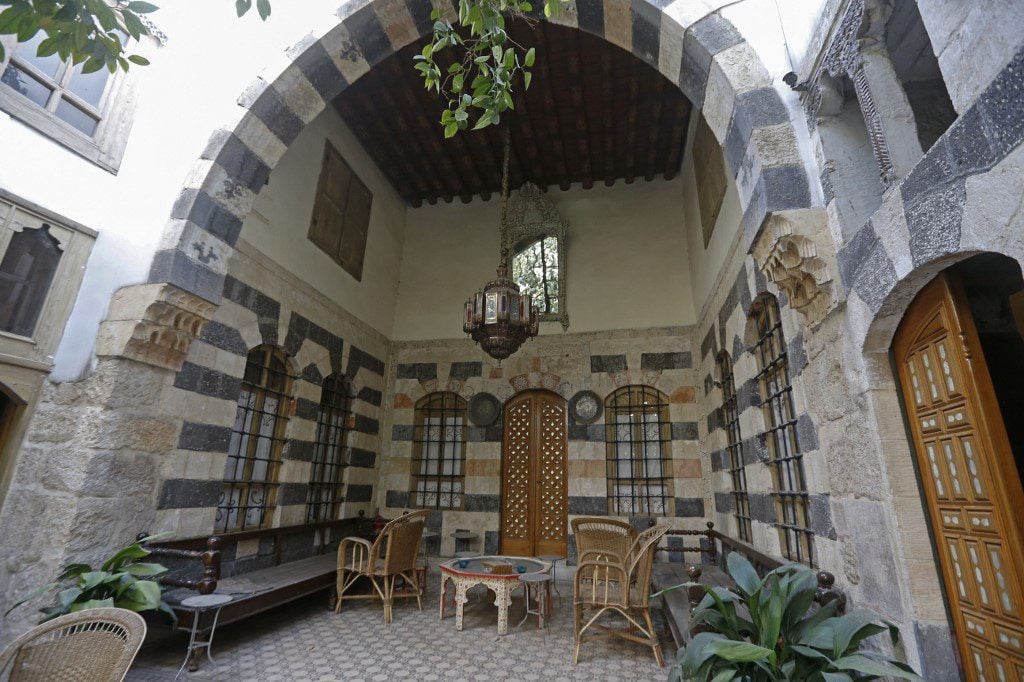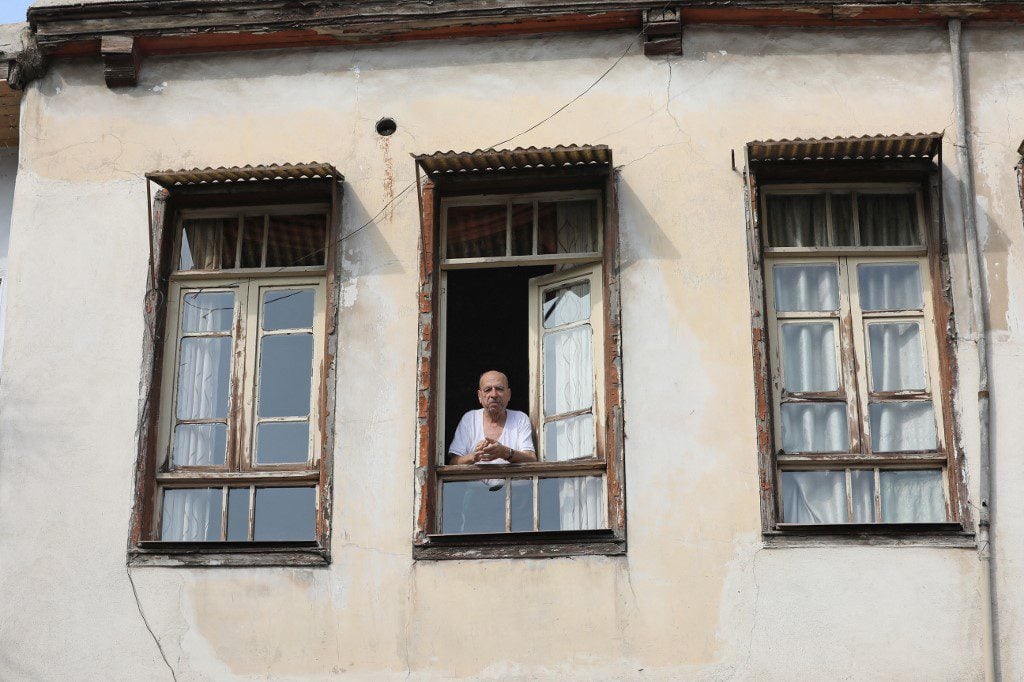A viral video on social media portraying the smuggling of one of Damascus' ancient houses to Qatar frustrated almost all Syrians.

Hussein Ali Alzoubi
Damascus ancient houses have been reduced to a commodity in the hands of antiquity smugglers. Once homes to owners and museums to visitors, these houses and their architectural identity are at risk of being lost. Nowadays, they are disassembled and smuggled out of Damascus and its seven gates.
Recently, a viral video on social media portraying the smuggling of one of Damascus’ ancient houses to Qatar frustrated almost all Syrians. The video shows a majestic house of more than 240 years old at the Sheikh Faisal Bin Qassim Al Thani Museum in Qatar. According to the video, the house belonged to Haqqi al-Azm, the first prime minister of the Republic of Syria, which was founded during the French Mandate in 1932.
The house consists of an outside courtyard, a fountain in a pond, a terrace, and rooms with original furnishings and marble decorations. The house was professionally reassembled in the Qatari museum and included an identification card with Haqqi’s name.
Journalist Nidal Maalouf revealed the details of the smuggling. He confirmed that the house was smuggled, right under the state’s nose, between 2014 and 2015. According to Maalouf, the house was disassembled entirely, including all its precious and decorative collectables, walls, ceilings and floors.
Based on information from his private sources, Maalouf explained the mechanism of transporting the Damascene house. “Transporting houses isn’t new, but it is a decades-old practice,” says Maalouf, “Original pieces are usually disassembled and replaced with identical fakes instead.”
Hamza Sabaqani, a researcher of Damascene heritage, confirmed Maalouf’s statements. He noted that national and foreign parties had had their eyes on Damascene houses prior to 2000 when these houses were converted into restaurants, cafes and hotels. Since investors advanced deeply into these regions, other operations appeared, such as gold mining, excavations of antiquities, and the replacement of houses’ original pieces with fake elements.
Sabaqani says, “The Syrian regime facilitates smuggling. These crimes are supervised by groups connected with international networks specialising in antiquity excavation, disassembling and smuggling.”
The criminal security branch in Damascus had previously announced the arrest of groups digging inside Damascus’ old houses, looking for gold and antiquities. Ahmed al-Bakry, head of the Criminal Chamber of the Court of Cassation, does not consider this phenomenon foreign to Syrian society.
According to the Directorate-General for Antiquities and Museums, the old Damascene houses total around 6000 estates. 3300 of these houses are residential, while the remaining number has a different function. Of these remaining buildings, 1560 are either publicly or privately owned, and 1140 have suspended ownerships, in which case ownership has been neither restored nor cancelled. Most of these houses are considered or at least categorised as antiquities. Ownership of these houses is intertwined between the Directorate of Antiquities, the Damascus governorate and the Ministry of Endowments, which makes documenting the buildings’ ownership papers and licences extremely difficult.
Mazen Ferzli, head of the Damascus Directorate, confirmed that over 56 houses had been turned into heritage hotels, noting that they had retained the features of an Arab house after restoration. According to Ferzli, some who receive a restoration permit do not comply with restoration requirements, such as the use of adobe, wood and stone as materials for restoration. They instead use bricks and cement, violating the restoration conditions.
Political Dimensions

Sabaqani believes that the interest in old Damascene neighbourhoods is not purely for investment but a desire to own and change that heritage. He also referred to the pressure on house owners to sell their properties. He says, “Through brokers and auctioneers, Iran is trying to take over Damascus, especially the old neighbourhoods, through persuasion and intimidation. Some Iranian parties have bought many estates in Damascene neighbourhoods, like al-Shaghour and Bab Touma.”
In December 2018, the Lebanese al-Modon newspaper reported that over 8000 estates had been sold to Shiite Iranians and Iraqis since the Syrian Revolution. The report mentioned the Iranian embassy’s role in facilitating ownership transfers, obtaining the necessary security permits for the buyer and seller, and assisting with procedures for restoration permits.
History professor Morhaf al-Laham says that besides the Iranian attempts to obtain ownership of old Damascene houses, there, too, are Israeli attempts and demands for the compensation of Syrian Jews’ properties either on their or their heirs’ behalf.
Wealthy Jews had built several palaces in Damascus, such as Lisbona, Farahi, Shamaya, and Khawaja Islambolli. There are ten Jewish synagogues in Damascus alone, the most notable of which are Souq al-Jom’ah and the destroyed and looted Jobar.
Turkey has also taken an interest in old Damascus, where countless Ottoman Turkish antiquities are located, such as Medhat Basha Souq, Marjeh Square, Lala Pasha Mosque, Tankiz Mosque and Hospice Sulaymaniyah. Additionally, there are three shrines for the first martyrs of the Ottoman Air Force. In 2009, the Turkish embassy undertook several restorations in the old city.
Greedy Investments
Investors set their eyes on Damascus’ old houses to convert them into restaurants and hotels. They sought the spaciousness and architectural and artistic features of these houses. Typically, these houses are spacious and include an expansive yard with a central fountain surrounded by multiple rooms.
Most old Damascene houses have cracks, and water leaks from the ceiling in the winter. The poor financial situation of many owners and the difficulty of obtaining a restoration permit from the governorate have made these buildings easy prey for investors.
Al-Laham, a resident of the al-Qaimarryeh’s neighbourhood, believes that transforming all of old Damascus into restaurants and hotels while pushing out its residents negates its historical value, particularly since it is part of the World Heritage list. He adds, “Welcoming investors to Damascus with arms wide open will damage the city’s reputation, especially since many of them are unaware of the traditions in these regions.”
Al-Laham fears that investment projects will overtake all heritage neighbourhoods, mainly because the necessary restoration operations for these depreciated houses pick up only once the buildings are allotted for investment. Irrespective of statements regarding protection and regulations, restoration takes place solely in line with this type of investment. Moreover, conditions and restrictions regarding antiquity and tourism are forced upon owners and residents but disappear for investors in the tourism industry, especially those in the restaurant and hotel business that has invaded the region.
Damascus’ old neighbourhoods comprise 5 per cent of the Syrian capital. Old Damascus has been on UNESCO’s World Heritage list since 1979.
The Law and Reclamation

Syrian law describes antiquities as “fixed or movable properties built, manufactured, produced, written, or drawn before 200 calendar years or 206 Hijri years.” The law allowed the ownership of historical structures not owned by the state to remain with their owners or residents. Yet, they are not allowed to utilise these structures for anything other than their initial purpose. Official antiquity bodies have the right to use the structures for humanitarian or cultural purposes.
The smuggling or attempted smuggling of antiquities is punishable by imprisonment of 15 to 25 years, in addition to a fine between 500,000 and 1,000,000 Syrian pounds. The matter is subject to the General Penal Code if a building is not registered as antiquity with the Directorate of Antiquities and the real estate registry.
Abd al-Nasser Houshan, a member of the Free Syrian Lawyers Association, emphasises that owners of registered antiquities are forbidden from demolishing, moving, restoring or changing them in any way, shape or form without a permit from the Directorate of Antiquities. He adds, “If Haqqi al-Azm’s house meets these conditions and is registered in the real estate registry as an archaeological building at the time it was being dismantled, transported and smuggled, then it is considered a punishable criminal offence, described in Article 56 of the Antiquities Law.”
Regarding the feasibility of reclaiming Haqqi’s house, Houshan believes that it depends on the Directorate of Museums’ decision, as it is the authorised body to categorise and register the house as antiquity. He adds, “If the directorate is complicit in smuggling the house, it is probable that it had taken the necessary legal measures before disassembling and smuggling. The directorate can do that through its authorities categorising, registering, and numbering these buildings.”
UNESCO put together a comprehensive collection of documents to protect cultural heritage. The 1954 Hague Convention for the Protection of Cultural Property in the Event of Armed Conflict and its protocols also includes additional international standards that allow for addressing the specific risks faced by heritage properties in times of conflict.
Old Damascus features an abundance of historical elements. The list includes ancient neighbourhoods, markets, inns, mosques, synagogues, schools, cobbled streets, the citadel and the Roman Wall. Old Damascus ranks 20th on UNESCO’s World Heritage Cities. The city is considered the most ancient inhabited city and the oldest capital in the world.
UN Security Council Resolution 2139 called for the protection of heritage and cultural diversity in Syria. According to the Statute of the International Criminal Court, intentionally directing attacks against historic monuments is a war crime. This clause could be a central pillar for protecting historic buildings in old Damascus.


